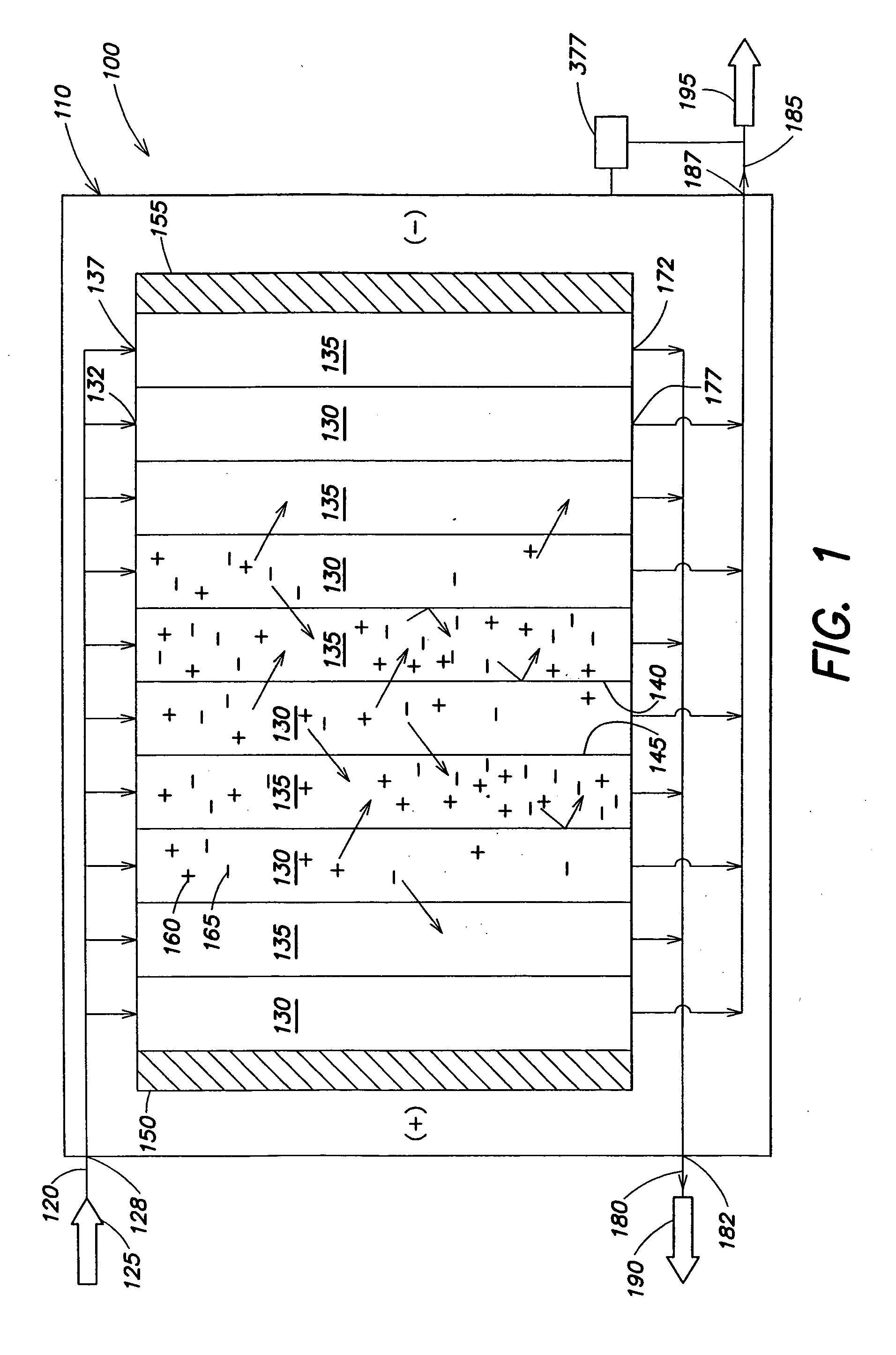Regeneration of adsorption media within electrical purification apparatuses
- Summary
- Abstract
- Description
- Claims
- Application Information
AI Technical Summary
Benefits of technology
Problems solved by technology
Method used
Image
Examples
example 1
[0102] This example illustrates the use of an electrodeionization device, in accordance with one embodiment of the invention. An electrical purification apparatus, including an electrodeionization device, was assembled, having a configuration similar to that shown in FIG. 3. In this system, the electrodeionization device was set up to provide polarity reversal and to run essentially continuously. The electrodeionization device included 20 cell pairs (i.e., 20 pairs of adjacent concentrating and diluting compartments), with each cell having a thickness of about 0.23 cm (about 0.09 in), and a flow path length within each cell of about 66 cm (about 26 in). In each cell, liquid flows from the top of the cell, to the bottom of the cell; then, the liquid entered the next cell, at the bottom, and flows to the top. The operating conditions of the electrodeionization device were selected such that the device was able to produce a purified liquid at a product flow rate of about 2.27 l / min (ab...
example 2
[0107]FIG. 7 illustrates another experiment using a similar electrical purification apparatus as the one described in Example 1 and illustrated in FIG. 3, but, compared with the operating conditions of Example 1, in the present example, the system was operated with a somewhat lower concentration of Ca2+ in the feed stream, about 16 ppm. The remaining ion concentrations were as follows: 100 ppm HCO3−, 70 ppm Mg2+, 160 ppm Na+, 50 ppm SO42−, and 96 ppm Cl31 . The regeneration solution was 10 wt % NaCl, applied for 30 minutes to the resin every six hours. An experiment was performed for about 6 hours, and some of the data from one cycle of the experiment are presented in FIG. 7.
[0108] It was observed that, while the concentration of Ca2+ in the feed remained constant during the experiment at about 16 ppm, the electrical purification apparatus was able to remove nearly all Ca2+ from the feed stream, resulting in a product (“dilute”) stream, generally having a negligible concentration o...
example 3
[0110] This example illustrates the essentially continuous use of certain electrical purification apparatuses, according to various embodiments of the invention. An electrical purification apparatus was assembled, similar to the one illustrated in FIG. 3. The electrical purification apparatus included an electrodeionization device, which included five pairs of cells (i.e., five pairs of concentrating and diluting compartments). Each of the cells had a thickness of about 0.23 cm (about 0.09 in), and a flow path length of about 38 cm (about 15 in). The operating conditions of the electrodeionization device were set such that the device was able to produce a product flow rate of about 0.4 l / m. The voltage applied to the electrodeionization device during operation was about 3 V / cell pair (about 30 V total). The feed stream introduced into the electrical purification apparatus was hard water including about 200 ppm of TDS, including a hardness of about 17 mg / l of CaCO3− (about 1 gr / gal h...
PUM
| Property | Measurement | Unit |
|---|---|---|
| Fraction | aaaaa | aaaaa |
| Fraction | aaaaa | aaaaa |
| Fraction | aaaaa | aaaaa |
Abstract
Description
Claims
Application Information
 Login to View More
Login to View More - R&D
- Intellectual Property
- Life Sciences
- Materials
- Tech Scout
- Unparalleled Data Quality
- Higher Quality Content
- 60% Fewer Hallucinations
Browse by: Latest US Patents, China's latest patents, Technical Efficacy Thesaurus, Application Domain, Technology Topic, Popular Technical Reports.
© 2025 PatSnap. All rights reserved.Legal|Privacy policy|Modern Slavery Act Transparency Statement|Sitemap|About US| Contact US: help@patsnap.com



